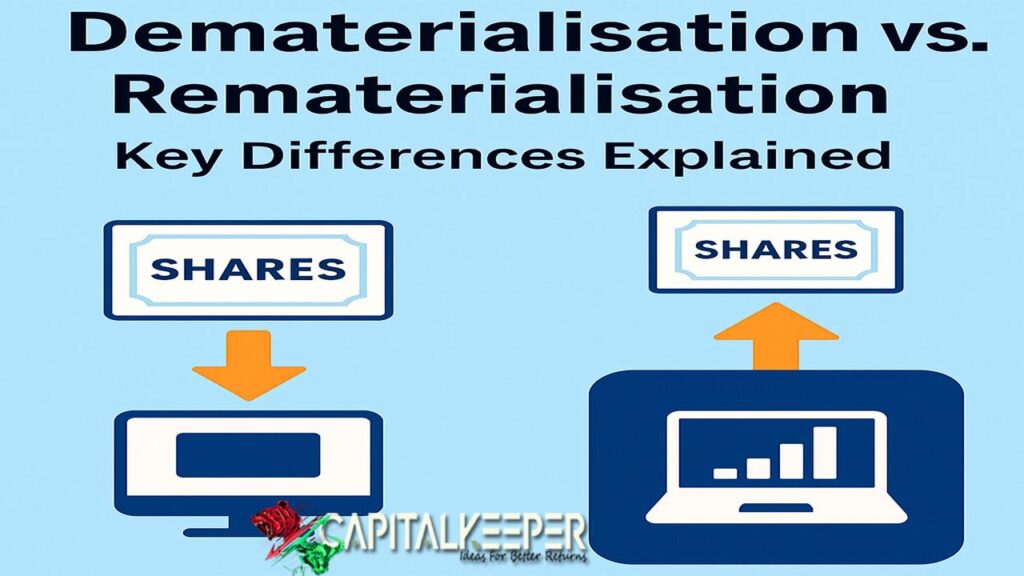Dematerialisation vs. Rematerialisation: Key Differences Explained for Modern Investors
By CapitalKeeper | Beginner’s | Indian Sock Market | Market Moves That Matter I 22th June 2025
With the rise of digital investing in India, dematerialisation and rematerialisation are two fundamental concepts every equity investor must understand. While both processes deal with the form in which your shares are held, their purpose and implications are vastly different.
This blog breaks down the key differences, use-cases, processes, and impact of these two terms with real-market relevance.
📌 What Is Dematerialisation?
Dematerialisation is the process of converting physical share certificates into electronic form, which are then stored in your demat account with a Depository Participant (DP) such as NSDL or CDSL.
✅ Why It Matters:
- Enables seamless buying/selling of stocks online
- Reduces paperwork and risk of loss or fraud
- Required for trading on stock exchanges (BSE/NSE)
📈 Example: If you inherited 100 shares of TCS in physical form, you must dematerialise them to sell or pledge them digitally.
📎 What Is Rematerialisation?
Rematerialisation is the reverse process—converting electronic holdings from your demat account back into physical share certificates.
🛑 Why It Happens:
- Investor wants to hold shares off the grid (offline)
- For long-term storage without trading
- Personal or compliance-related reasons (like legacy transfer or litigation cases)
🔁 It’s rarely used today but remains a legal option.
🔍 Key Differences at a Glance
| Feature | Dematerialisation | Rematerialisation |
|---|---|---|
| Purpose | Convert physical shares to electronic | Convert electronic shares to physical |
| Mode | Online/digital | Offline/manual |
| Common Users | Traders, investors, institutions | Legacy investors, specific legal requirements |
| Processing Time | 15–30 days | 30+ days |
| Forms Involved | DRF (Demat Request Form) | RRF (Remat Request Form) |
| Cost | Nominal DP charges | Higher due to printing, courier, etc. |
🧾 Process of Dematerialisation
- Open a Demat Account with a registered DP
- Submit Demat Request Form (DRF) along with physical share certificates
- DP sends it to registrar/company
- On approval, electronic credit is made to your demat account
🕐 TAT: Usually 2 to 4 weeks
🧾 Process of Rematerialisation
- Submit Rematerialisation Request Form (RRF) to your DP
- DP sends the request to the depository
- Registrar issues new physical certificates
- Couriered to your registered address
⚠️ Some brokers discourage it due to low demand
🔧 When Should You Choose Which?
| Scenario | Go for Dematerialisation | Go for Rematerialisation |
|---|---|---|
| Planning to trade/sell | ✅ | ❌ |
| Want secure, paperless storage | ✅ | ❌ |
| Legacy transfer or legal proceedings | ❌ | ✅ |
| Personal preference for paper certificates | ❌ | ✅ |
📢 Market Insight: SEBI’s Push Toward Full Dematerialisation
SEBI has been aggressively promoting demat-only shareholding to reduce fraud, improve efficiency, and ensure transparency. All IPOs, bonus shares, rights issues are now credited only in demat form.
🚫 From 2024, transfers of physical shares (except transmission or succession) have been disallowed entirely.
🧠 Final Thoughts
While dematerialisation is now the market standard, rematerialisation still holds significance in niche cases. As an investor, understanding both gives you a better handle on managing your equity assets—whether you’re actively trading or preserving legacy holdings.
📌 Always verify DP charges and service timelines with your broker before initiating either process.
📌 For more real-time updates, trade setups, and investment insights — follow us on [Telegram] and subscribe to our newsletter!
📌 Disclaimer
The content provided on CapitalKeeper.in is for informational and educational purposes only and does not constitute investment, trading, or financial advice. While we strive to present accurate and up-to-date market data and analysis, we make no warranties or representations regarding the completeness, reliability, or accuracy of the information.
Stock market investments are subject to market risks, and readers/investors are advised to conduct their own due diligence or consult a SEBI-registered financial advisor before making any investment decisions. CapitalKeeper and its authors are not liable for any loss or damage, direct or indirect, arising from the use of this information.
All views and opinions expressed are personal and do not reflect the official policy or position of any agency or organization. Past performance is not indicative of future results.
By using this website, you agree to the terms of this disclaimer.
CapitalKeeper | Turning Market Noise into Market Wisdom
🔗 Visit CapitalKeeper.in

